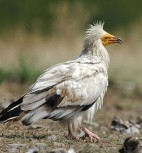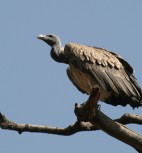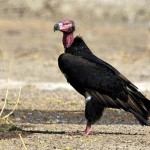 There are more than 10 species of vultures that are found in Pakistan. Species of vultures are facing catastrophic decline mainly because of a drug named Diclofenac. Most of this turn down is observed in the numbers of vultures in South Asia making them critically endangered spices. In 2004, WWF Pakistan in association with the Federal Ministry of Environment and IUCN Pakistan set a one day seminar on the Vulture Conservation at its chief Office on the 2nd September. The key purpose of this workshop was to bring together all the stakeholders to speak to the disastrous vulture cry off in South Asia.
There are more than 10 species of vultures that are found in Pakistan. Species of vultures are facing catastrophic decline mainly because of a drug named Diclofenac. Most of this turn down is observed in the numbers of vultures in South Asia making them critically endangered spices. In 2004, WWF Pakistan in association with the Federal Ministry of Environment and IUCN Pakistan set a one day seminar on the Vulture Conservation at its chief Office on the 2nd September. The key purpose of this workshop was to bring together all the stakeholders to speak to the disastrous vulture cry off in South Asia.
Vultures have a  tremendously imperative ecological role as they are purifier of nature and their decline will sooner or later enhance the stray dog population which is also a vigor hazard for human population. These species also have holy significance to Parsi communities. Diclofenac is an extensively used medicine in farm animals and builds up in the kidneys of vultures when they feed on remains and ultimately leads to their fatality. Research has shown that one in 250 rotting carcass is sufficient to trigger this accelerated down fall as vultures range usually and feed jointly. proposals from this workshop aided in developing the conservation map for this species.
 This species of vultures is commonly known as Lammergeier, the bearded vulture. They are frequently found in the mountainous terrains and open ranges of Pakistan. Hilly regions of Africa, Southern Europe and Asia have a fair number of these vultures.
The Bearded vulture is close to 4 feet in size from head to tail, its wingspan is almost 8 feet and it weighs about 5-7 kgs. Their head is roofed with...
This species of vultures is commonly known as Lammergeier, the bearded vulture. They are frequently found in the mountainous terrains and open ranges of Pakistan. Hilly regions of Africa, Southern Europe and Asia have a fair number of these vultures.
The Bearded vulture is close to 4 feet in size from head to tail, its wingspan is almost 8 feet and it weighs about 5-7 kgs. Their head is roofed with...
 These vultures, as the name suggests, are common chiefly in the higher regions of the Himalayas, Kazakhstan, the Pamirs and on the Tibetan. In Pakistan they exist in Ayubia National Park, Chitral Gol National Park and high in the Himalayan range. Immature birds might though scatter more in the south and vagabonds have been recorded in Thailand, Burma, Singapore and Cambodia.
This species is more frequently referred as Himalayan Griffon Vulture (Gyps himalayensis) is an Old World vulture in the Accipitridae family. Intimately related to the European Griffon Vulture...
These vultures, as the name suggests, are common chiefly in the higher regions of the Himalayas, Kazakhstan, the Pamirs and on the Tibetan. In Pakistan they exist in Ayubia National Park, Chitral Gol National Park and high in the Himalayan range. Immature birds might though scatter more in the south and vagabonds have been recorded in Thailand, Burma, Singapore and Cambodia.
This species is more frequently referred as Himalayan Griffon Vulture (Gyps himalayensis) is an Old World vulture in the Accipitridae family. Intimately related to the European Griffon Vulture...
 The Silk Vulture (Neophron percnopterus) is a small Old World vulture, found commonly allocated from north western European countries and southern region African-american to lower Japan. It is the only living member of the genus Neophron. It has sometimes also been known as the Light Scavenger Vulture or Pharaoh's Hen. Like other birds it soars on thermals and the underwing non colored documents design and pitching wedge trail create it unique. It sometimes uses rocks to break the egg of wildlife making it one of the few wildlife that create...
The Silk Vulture (Neophron percnopterus) is a small Old World vulture, found commonly allocated from north western European countries and southern region African-american to lower Japan. It is the only living member of the genus Neophron. It has sometimes also been known as the Light Scavenger Vulture or Pharaoh's Hen. Like other birds it soars on thermals and the underwing non colored documents design and pitching wedge trail create it unique. It sometimes uses rocks to break the egg of wildlife making it one of the few wildlife that create...
 In the year 1985 the species was described as "probably the most plentiful large bird of prey in the world" and often measured a nuisance but is at the moment rare and faces a very high risk of extinction in the near future. The species was in attendance in great numbers, in Southern and Southeastern Asia until the 1990s and declined swiftly in numbers since; up to 99.9 % between 1992 and 2007.
Like other vultures it is a forager and a scavenger, nourishing mostly from...
In the year 1985 the species was described as "probably the most plentiful large bird of prey in the world" and often measured a nuisance but is at the moment rare and faces a very high risk of extinction in the near future. The species was in attendance in great numbers, in Southern and Southeastern Asia until the 1990s and declined swiftly in numbers since; up to 99.9 % between 1992 and 2007.
Like other vultures it is a forager and a scavenger, nourishing mostly from...
 Commonly identified as Long-billed Vulture, the Indian Vulture breeds mainly on crags in the mountains of Pakistan and India. It is a forager and a scavenger, feeding on dead animals which it finds by towering in flocks over savannah and around human being habitation. It has hairless head, very wide wings and short tail feathers. It weighs 12 to 14 lbs, measures 2.5 – 3.25...
Commonly identified as Long-billed Vulture, the Indian Vulture breeds mainly on crags in the mountains of Pakistan and India. It is a forager and a scavenger, feeding on dead animals which it finds by towering in flocks over savannah and around human being habitation. It has hairless head, very wide wings and short tail feathers. It weighs 12 to 14 lbs, measures 2.5 – 3.25...
 In Pakistan they are commonly found in Salt Range Wetlands Complex and meadows or the come migrating from higher altitudes. The vultures are a Eurasian species. The western confines of its range are in Spain and inland Portugal, with a reintroduced population in south France. They occur discontinuously to Greece, Turkey and right through the central Middle East. Their range continues through Pakistan and northern India to its eastern limits in central Asia, where they breed in northern China, Manchuria, Mongolia...
In Pakistan they are commonly found in Salt Range Wetlands Complex and meadows or the come migrating from higher altitudes. The vultures are a Eurasian species. The western confines of its range are in Spain and inland Portugal, with a reintroduced population in south France. They occur discontinuously to Greece, Turkey and right through the central Middle East. Their range continues through Pakistan and northern India to its eastern limits in central Asia, where they breed in northern China, Manchuria, Mongolia...
 They are generally known as Red headed Vulture and they are scavenger by personality as most of the other vulture species and widespread in South Asia. The number of this species has fundamentally halved every other year since the late 1990s, and what on one occasion was a abundant species numbering in the hundreds of thousands has drawn dangerously close to extermination in fewer than...
They are generally known as Red headed Vulture and they are scavenger by personality as most of the other vulture species and widespread in South Asia. The number of this species has fundamentally halved every other year since the late 1990s, and what on one occasion was a abundant species numbering in the hundreds of thousands has drawn dangerously close to extermination in fewer than...
 There are more than 10 species of vultures that are found in Pakistan. Species of vultures are facing catastrophic decline mainly because of a drug named Diclofenac. Most of this turn down is observed in the numbers of vultures in South Asia making them critically endangered spices. In 2004, WWF Pakistan in association with the Federal Ministry of Environment and IUCN Pakistan set a one day seminar on the Vulture Conservation at its chief Office on the 2nd September. The key purpose of this workshop was to bring together all the stakeholders to speak to the disastrous vulture cry off in South Asia.
There are more than 10 species of vultures that are found in Pakistan. Species of vultures are facing catastrophic decline mainly because of a drug named Diclofenac. Most of this turn down is observed in the numbers of vultures in South Asia making them critically endangered spices. In 2004, WWF Pakistan in association with the Federal Ministry of Environment and IUCN Pakistan set a one day seminar on the Vulture Conservation at its chief Office on the 2nd September. The key purpose of this workshop was to bring together all the stakeholders to speak to the disastrous vulture cry off in South Asia.




 In Pakistan they are commonly found in Salt Range Wetlands Complex and meadows or the come migrating from higher altitudes. The vultures are a Eurasian species. The western confines of its range are in Spain and inland Portugal, with a reintroduced population in south France. They occur discontinuously to Greece, Turkey and right through the central Middle East. Their range continues through Pakistan and northern India to its eastern limits in central Asia, where they breed in northern China, Manchuria, Mongolia...
In Pakistan they are commonly found in Salt Range Wetlands Complex and meadows or the come migrating from higher altitudes. The vultures are a Eurasian species. The western confines of its range are in Spain and inland Portugal, with a reintroduced population in south France. They occur discontinuously to Greece, Turkey and right through the central Middle East. Their range continues through Pakistan and northern India to its eastern limits in central Asia, where they breed in northern China, Manchuria, Mongolia...